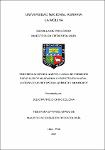Mostrar el registro sencillo del ítem
Identificación del agente causal de pudrición radicular de mandarina Cleopatra en Huaral, alternativas de control químico y biológico
| dc.contributor.advisor | Mattos Calderón, Luz Leonor | |
| dc.contributor.author | Chino Coloma, Julio Patricio | |
| dc.date.accessioned | 2023-05-22T17:39:56Z | |
| dc.date.available | 2023-05-22T17:39:56Z | |
| dc.date.issued | 2023 | |
| dc.identifier.uri | https://hdl.handle.net/20.500.12996/5810 | |
| dc.description | Universidad Nacional Agraria La Molina. Escuela de Posgrado. Maestría en Fitopatología | es_PE |
| dc.description.abstract | En el Perú, Huaral destaca como la más importante y dinámica zona productora de cítricos del país, pero a menudo es afectado por enfermedades de pudrición radicular que reducen la producción. Por tal motivo, el objetivo de la investigación ha sido identificar la especie o las especies de oomicetos pertenecientes al género Phytophthora que afectan el sistema radicular y evaluar la eficacia del control químico y biológico. Se extrajeron muestras de raíces secundarias con síntomas de pudrición radicular y de suelo, de varios campos de cultivo de cítricos en Huaral. Los aislamientos y la purificación se realizaron en medio selectivo CMA-PAR (PH) para Phytophthora, obteniéndose ocho aislamientos. La prueba de patogenicidad resultó positiva para cinco aislamientos. La identificación de los aislamientos patogénicos fue mediante la caracterización morfométrica y molecular. En la caracterización morfométrica los aislamientos presentaron micelio cenocítico, esporangios (papilados, no caducos, generalmente ovoides, esféricos y muy pocos obpiriformes), clamidosporas (intercalares y terminales), heterotálicos, oogonios esféricos y lisos, anteridios anfígenos y oospora aplerótica; por consiguiente, según la clave de identificación de Erwin y Ribeiro (1996), correspondió a la especie Phytophthora nicotianae. La identificación molecular se realizó mediante la amplificación por PCR convencional de la región cox II del ADNmt e ITS del ADNr, utilizando los cebadores FM66 / FM58 e ITS6 / ITS4, respectivamente; confirmándose la identificación para la especie Phytophthora nicotianae. En la prueba de control químico in vitro los productos a base de metalaxyl, fosetyl aluminio y extracto de lauráceas fueron los mejores. En la prueba de control biológico in vitro el mejor resultado se obtuvo con Trichoderma harzianum T-22. En invernadero el mejor control químico se obtuvo con los productos fosfito de calcio, fosfito de potasio, ácidos urónicos y metalaxyl. En la prueba de control biológico el mejor resultado se obtuvo con Bacillus subtilis AP-01 | es_PE |
| dc.description.abstract | In Peru, Huaral stands out as the most important and dynamic citrus-producing area in the country, but it is often affected by root rot diseases that reduce production. For this reason, the objective of the research has been to identify the species or species of oomycetes belonging to the genus Phytophthora that affect the root system and evaluate the effectiveness of chemical and biological control. Secondary root samples with symptoms of root and soil rot were extracted from several citrus cultivation fields in Huaral. Isolations and purification were performed in CMA-PAR (PH) selective medium for Phytophthora, obtaining eight isolates. The pathogenicity test was positive for five isolates. The pathogenic isolates were identified by morphometric and molecular characterization. In the morphometric characterization, the isolates presented coenocytic mycelium, sporangia (papilate, not deciduous, generally ovoid, spherical and very few obpiriform), chlamydospores (intercalary and terminal), heterothallic, spherical and smooth oogonia, amphigenic antheridia and aplerotic oospore; therefore, according to the identification key of Erwin and Ribeiro (1996), it corresponded to the species Phytophthora nicotianae. Molecular identification was performed by conventional PCR amplification of the cox II region of mtDNA and ITS of rDNA, using primers FM66/FM58 and ITS6/ITS4, respectively; confirming the identification for the species Phytophthora nicotianae. In the in vitro chemical control test, the products based on metalaxyl, fosetyl aluminum and lauraceae extract were the best. In the in vitro biological control test, the best result was obtained with Trichoderma harzianum T-22. In the greenhouse, the best chemical control was obtained with the products calcium phosphite, potassium phosphite, uronic acids and metalaxyl. In the biological control test, the best result was obtained with Bacillus subtilis AP-01 | es_PE |
| dc.format | application/pdf | es_PE |
| dc.language.iso | spa | es_PE |
| dc.publisher | Universidad Nacional Agraria La Molina | es_PE |
| dc.rights | info:eu-repo/semantics/openAccess | es_PE |
| dc.rights.uri | https://creativecommons.org/licenses/by-nc-nd/4.0/ | es_PE |
| dc.subject | Control biológico | es_PE |
| dc.subject | Control químico | |
| dc.subject | Dosis de aplicación | |
| dc.subject | Experimentación | |
| dc.subject | Mandarina | |
| dc.subject | Organismos patógenos | |
| dc.subject | Perú | |
| dc.subject | Podredumbre de la raiz | |
| dc.subject | Pudrición radicular | |
| dc.subject | Respuesta de la planta | |
| dc.title | Identificación del agente causal de pudrición radicular de mandarina Cleopatra en Huaral, alternativas de control químico y biológico | es_PE |
| dc.type | info:eu-repo/semantics/masterThesis | es_PE |
| thesis.degree.discipline | Fitopatología | es_PE |
| thesis.degree.grantor | Universidad Nacional Agraria La Molina. Escuela de Posgrado | es_PE |
| thesis.degree.name | Magister Scientiae - Fitopatología | es_PE |
| dc.subject.ocde | https://purl.org/pe-repo/ocde/ford#4.01.07 | es_PE |
| renati.author.dni | 00791911 | es_PE |
| dc.publisher.country | PE | es_PE |
| dc.type.version | info:eu-repo/semantics/publishedVersion | es_PE |
| renati.advisor.orcid | https://orcid.org/0000-0003-4773-8582 | es_PE |
| renati.advisor.dni | 08284019 | es_PE |
| renati.type | https://purl.org/pe-repo/renati/type#tesis | es_PE |
| renati.level | https://purl.org/pe-repo/renati/level#maestro | es_PE |
| renati.discipline | 916107 | es_PE |
| renati.juror | Casas Díaz, Andrés Virgilio | |
| renati.juror | Cadenas Giraldo, Carlos Alberto | |
| renati.juror | Chura Chuquija, Julián |
Ficheros en el ítem
Este ítem aparece en la(s) siguiente(s) colección(ones)
-
M-FIT Tesis [29]





